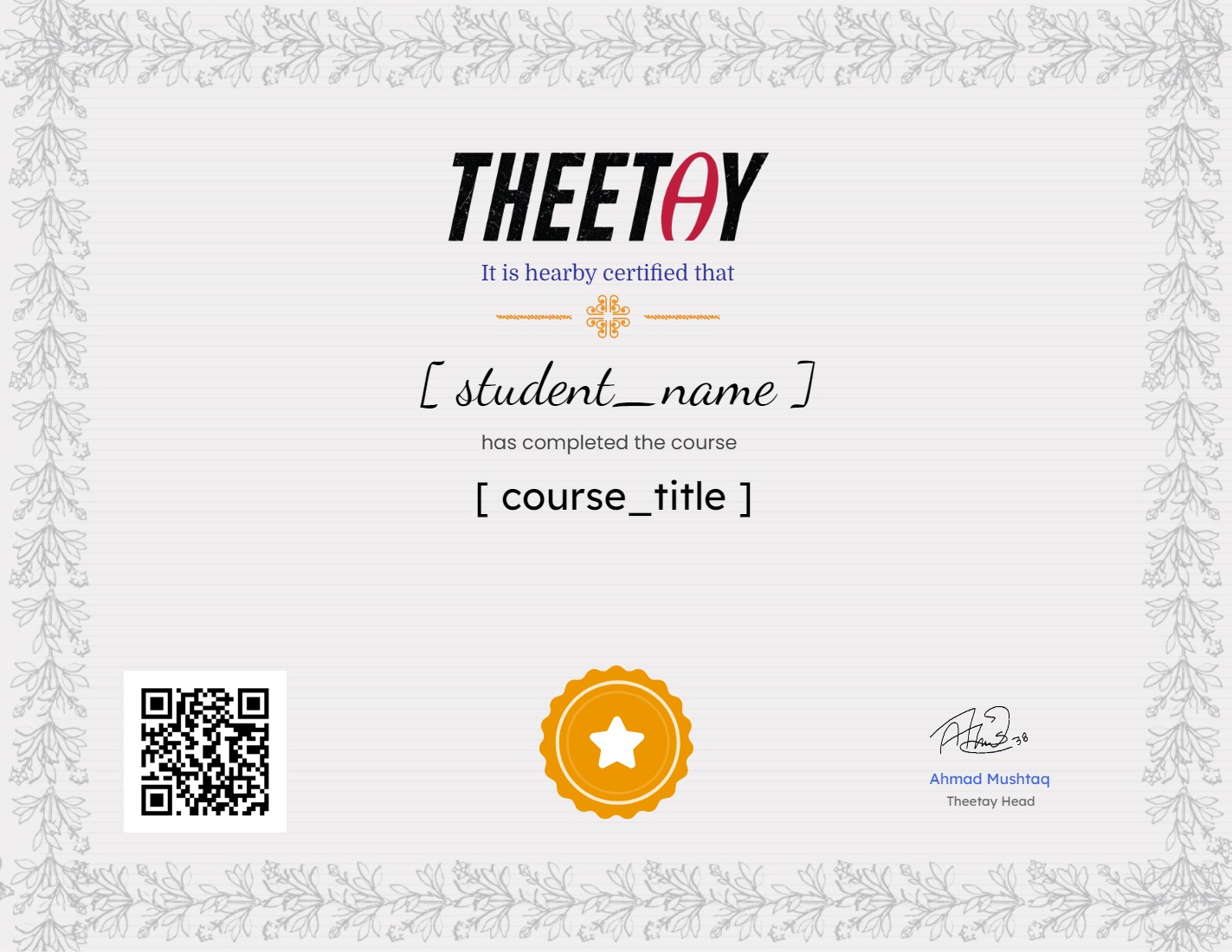Piping Design Engineering & Piping Isometrics Masterclass

About Course
Become a Piping System Expert with this free, comprehensive 10-hour masterclass. This course covers everything from the fundamentals of piping systems to the intricacies of isometric drawings, making it perfect for engineers, operators, managers, and anyone looking to advance their career in the industrial sector.
Learn from industry experts:
- Part I: Piping Systems: Explore essential concepts such as joining technologies, welding methods, pipe expansion handling, and support calculations.
- Part II: Piping Isometrics: Master the techniques to read, interpret, and create your own isometric drawings.
Key Highlights:
- Free Course: This valuable masterclass is completely FREE!
- Practical Approach: Learn through 3D animations, cross-sectional views, sizing tables, numerous practice sessions, and 300+ quiz questions.
- Real-World Examples: Gain insights from real industrial examples of Piping Isometrics.
- Industry Standards: Learn best practices based on ASME and ANSI codes and standards.
- Expert Guidance: Discover proven design methods used in petrochemical plants.
- Extensive Resources: Access downloadable resources and bonus materials throughout the course.
Offered on Top Learning Platforms: This course is available on leading online learning platforms such as Udemy, Udacity, Coursera, MasterClass, NearPeer, and more.
Unlock Your Potential: This masterclass will give you the knowledge and skills to excel in the field of piping systems.
Start your journey today and expand your knowledge with WR Training!
What Will You Learn?
- Learn a valuable step-by-step Piping Design Method and start designing your piping systems from scratch
- Download our valuable sizing tables and dimensioning charts, essential to properly design your piping system
- Download our valuable technical booklets covering Flanges & Valves
- Test your knowledge with our 300+ QUIZ QUESTIONS
- Build a strong understanding of piping design and construction principles for both metallic and nonmetallic piping systems
- Explain the various pipe manufacturing and joining methods
- Identify the different types of fittings and their application
- Identify the different types of flanges, gaskets, and bolting materials
- Identify the different types of valves, their basic parts and functions
- Identify the different types of control valves, their basic parts and functions
- Identify the different types of piping accessories (anchors, dummy and channel supports, spring hangers, hanger rods…)
- Gain guidance for selecting the most appropriate pipe specification and material for your application
- Gain guidance for selecting the most appropriate pipe spacing and arrangement to mitigate thermal expansion and successfully design your piping support systems
- Explain the process of pipe identification
- Appreciate the various piping classes based on the design and application
- Know and familiarize yourself with international and national pipe standards and specifications (ASME, ANSI, AFNOR…)
- Understand and evaluate the purpose, content, and importance of Piping Isometrics to the construction, commissionning, operation and maintenance of a plant
- Learn how to READ, INTERPRET and successfully UNDERSTAND ALL Piping Isometrics through numerous real industrial examples
- Learn how to DRAW your own Piping Isometrics through numerous real industrial examples
- Download our valuable sizing tables and dimensioning charts, essential to properly draft and issue your own Piping Isometrics
- Identify the 5 key sections of your Piping Isometrics (title block, grid system, revision block, notes and legend, engineering drawing block)
- Know and identify valve symbols on your Piping Isometrics (gate, globe, ball, butterfly, needle…)
- Know the standards and conventions for valve status (open, closed, throttled)
- Identify valve position and failure mode on your Piping Isometrics when applicable (LO, LC, FO, FC, FAI…)
- Know and identify process equipment symbols on your Piping Isometrics when applicable (pumps, compressors, heat exchangers, columns, furnaces, reactors…)
- Determine specific information about a process piping including type of material in the line, line size, line number and type of insulation when applicable
- Know and identify pipe fitting symbols on your Piping Isometrics (flanges, reductions, caps, spool pieces, unions…)
- Know and identify the Piping Isometric symbols of safety devices that are used to safely isolate, vent & drain process equipment for ease of maintenance
- Know and identify instrumentation symbols on your Piping Isometrics (flow meters, temperature transmitters, pressure gauges…)
- Know the lettering and numbering standards for piping, instruments and equipment designation on your Piping Isometrics
- Trace the flow of a process stream into your Piping Isometrics, through the pipes and equipment, and out of the Piping Isometrics
Course Content
About part 1 Piping system design. manufacturing and construction
-
A Message from the Professor
-
Introduction to part 12
03:49 -
Before you start this first part of the masterclass
02:46 -
Course Material Download Link
00:00
Pipe
-
Pipe materials
01:36 -
Manufacturing methods
10:00 -
Sizing of pipe
03:04 -
Wall thickness
05:33 -
More on the schedule system
02:21 -
Pipe selection
01:15 -
Methods of joining pipe
06:13 -
Cast iron pipe
02:42 -
Joining cast iron pipe
04:53 -
Plastic pipe
02:41 -
Joining plastic pipe
03:08 -
Drawing pipe
01:15 -
Before proceeding to the next section
00:24
Pipe fittings
-
Introduction to pipe fittings
03:43 -
90° elbows
01:54 -
Long-radius elbows
04:34 -
Short-radius elbows
01:44 -
Reducing elbows
01:14 -
Mitered elbows
02:20 -
45° elbows
02:34 -
Weld tee
04:30 -
Stub-in
03:18 -
Stub-in reinforcements
04:39 -
Coupling
02:01 -
Reducers
05:43 -
Weld caps
01:00 -
Use of fittings
05:00 -
Screwed and socket-weld fittings
06:05 -
Unions
00:53 -
Plugs
00:52 -
Pipe nipples
01:55 -
Swage nipples
04:44 -
Flanged fittings
00:41 -
Before proceeding to the next section
00:24
Flange basics
-
Introduction to flanges
03:31 -
Rating flanges
03:30 -
Flange facings
01:29 -
Flat Face flanges (FF)
01:21 -
Raised Face flanges (RF)
01:16 -
Ring-Type Joint flanges (RTJ)
02:00 -
Flange types
01:17 -
Weld neck flanges
04:59 -
Slip-on flanges
03:49 -
How to fit and weld slip-on flanges
01:32 -
Lap-joint flanges
02:16 -
Threaded flanges
01:35 -
Socket-weld flanges
00:51 -
Reducing flanges
02:37 -
Blind flanges
01:27 -
Orifice flanges
06:12 -
Bolts
04:37 -
Gaskets
05:34 -
Before proceeding to the next section
00:24
Valve basics Functions and basic parts
-
Important notes before starting this section on valves
02:25 -
Valve basics Learning objectives
00:54 -
Introduction
01:56 -
Valve body
02:13 -
Valve bonnet
01:44 -
Valve trim
01:24 -
Disk and seat
02:07 -
Stem
02:29 -
Valve actuator
01:04 -
Valve packing
01:39 -
Introduction to the types of valves
02:45 -
Before proceeding to the next section
00:24
Valve basics Types of valves
-
Valve types Learning objectives
00:54 -
Numerous sizes, styles and pound ratings
00:55 -
Gate valves
02:50 -
Globe valves
02:50 -
Ball valves
01:07 -
Plug valves
01:05 -
Diaphragm valves
03:26 -
Pinch valves
02:41 -
Butterfly valves
04:49 -
Needle valves
02:05 -
Check valves
00:55 -
Relief and Safety valves
02:18 -
Safety valves
05:41 -
Relief valves
03:18 -
Control valves
04:08 -
For more details on valve types, assembling, dismantling and installation
00:22 -
Before proceeding to the next section
00:24
Valve actuator basics
-
Learning objectives
00:44 -
Introduction
00:41 -
Manual actuators
01:53 -
Electric motor actuators
01:30 -
Pneumatic actuators
03:34 -
Hydraulic actuators
01:00 -
Self-actuated valves
00:39 -
For more details on valve actuators
00:20
Standard piping details
-
Introduction
01:10 -
Piping rack spacing
04:52 -
Pipe flexibility
05:54 -
Heat expansion
03:46 -
Pipe anchors
02:15 -
Pipe insulation shoes
01:42 -
Pipe guides
01:04 -
Pipe spans
02:30 -
Pipe supports
01:58 -
Field supports
05:38 -
Dummy supports
02:04 -
Hanger rods
02:19 -
Before proceeding to the next section
00:24
Piping codes & specifications
-
Introduction to piping codes & specifications
04:01 -
Piping codes
02:03 -
Specifications
03:23 -
Scope
00:28 -
Code requirements
00:33 -
Drawing
04:00 -
Piping
03:51 -
Instruments
00:58 -
Vents & drains
00:51 -
Kind reminder – General Piping Specifications
00:19 -
Orifices
00:39 -
Clearance & spacing
08:32 -
Insulation & painting
01:14 -
Fabrication tolerances
00:46 -
Shipping lengths
01:19 -
Piece marking & painting
00:45 -
Testing
00:52 -
Pipe labeling and color codes
05:14 -
Piping specification classes
03:05 -
Concrete example of a piping class
09:58 -
Before proceeding to the next section
00:24
Practice session Designing piping systems
-
Introduction
00:49 -
Piping design methodology Problem set-up
03:13 -
Piping design methodology A set by step guide
28:41
Introduction to mechanical equipment
-
Introduction
02:14 -
Horizontal vessels
02:27 -
Vertical vessels
02:02 -
Ladders, Cages & Platforms
02:21 -
Pumps Overview
04:53 -
Pumps Nozzle arrangement
04:54 -
Pump drivers
01:53 -
Compressors Overview
01:26 -
Heat Exchangers Overview
01:58 -
Shell & Tube
01:12 -
Double pipe
01:25 -
Reboilers
01:59 -
Air fans
01:38 -
Cooling towers
02:16 -
Furnaces
01:56 -
Storage tanks
03:34 -
Before proceeding to the next section
00:24
Downloadable resources – part 12
-
Summary of part 12 downloadable resources
00:35
About part 2 Piping isometrics
-
Introduction to part 22
03:14 -
Before you start this second part of the masterclass
02:33
About piping isometrics
-
What is an isometric
02:32 -
Why is an isometric so important
02:20 -
How do isometrics look like
06:29 -
Intro to isometric piping symbols
02:58 -
Isometric orientation
04:07
Introduction to isometric reading
-
Learning objectives
00:56 -
Introduction to piping isometric reading
01:37 -
Anatomy of a piping isometric drawing
01:11 -
The title block
02:58 -
The drawing scale
03:19 -
The grid system
02:13 -
The revision block
03:19 -
Changes
02:19 -
Notes and legend
03:24 -
Section wrap-up
00:59
Basic isometric symbols
-
Draft Lesson
02:55 -
Valve symbols
14:00 -
Valve actuator symbols
08:50 -
Draft Lesson
01:37 -
Standards and conventions for valve status
07:00 -
Process equipment symbols
12:24 -
Piping symbols
03:08 -
Pipe fitting symbols
02:33 -
Isolating, venting & draining symbols for ease of maintenance
05:20 -
Instrumentation
02:39 -
Draft Lesson
04:18 -
Location symbols
04:21
Piping isometric codes
-
Piping isometric codes Learning objectives
01:42 -
Piping designation code
05:47 -
Equipment designation code
02:46 -
Instrument designation code
01:39 -
Miscellaneous designation codes
02:02
Drawing piping isometrics
-
Drawing piping isometrics Learning objectives
00:53 -
Introduction
01:38 -
The drawing procedure
04:40 -
Isometric coordinates
02:30 -
Dimensions, notes and callouts
06:27 -
Isometric offsets
04:30 -
Dimensioning offsets
03:59 -
Multi-angle offsets
08:19 -
Rolling offsets
04:26 -
Dimensioning rolling offsets
05:20 -
Simplifying the calculations
03:10
Isometrics practice session
-
Piping isometric example #1
05:42 -
Piping isometric example #2
06:44 -
Piping isometric example #3
04:59 -
Piping isometric example #4
01:49 -
Piping isometric example #5
06:06
Downloadable resources – part 22
-
Downloadable resources part 22
00:19
Extra
-
Bonus
01:10
Earn a certificate
Add this certificate to your resume to demonstrate your skills & increase your chances of getting noticed.



